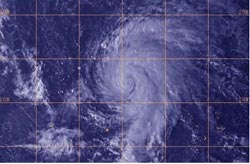Tropical Storm Lekima born in northwestern Pacific Ocean

This visible image of Tropical Storm Lekima was obtained by Japan's MTSAT-2 satellite on Oct. 21 at 0532 UTC/1:32 a.m. EDT.<br><br>Credit: JAXA/NRL<br>
On Oct. 21 at 1500 UTC/11 a.m. EDT, Tropical Storm Lekima had maximum sustained winds near 55 knots/63.2 mph/101.9 kph.
It was centered near 13.6 north and 159.4 east, about 815 nautical miles/ 937.9 miles/1,509 km east of Saipan. Lekima was moving to the north-northwest at 10 knots/11.5 mph/18.5 kph.
A visible image of Tropical Storm Lekima was obtained by Japan's MTSAT-2 satellite on Oct. 21 at 0532 UTC/1:32 a.m. EDT. Additional infrared satellite imagery showed that the tropical storm was organizing and consolidating.
Imagery showed that bands of thunderstorms were wrapping around the well-defined center of circulation, and a pinhole eye-like feature.
Forecasters at the Joint Typhoon Warning Center expect Lekima to strengthen to typhoon strength in the next day. Lekima's maximum sustained winds are expected to peak near 115 knots/132.3 mph/213 kph by Oct. 24 as it continues to move over open waters of the Northwestern Pacific. Lekima is forecast to approach Iwo To on Oct. 24, and then turn to the northeast away from the island.
Media Contact
More Information:
http://www.nasa.govAll latest news from the category: Earth Sciences
Earth Sciences (also referred to as Geosciences), which deals with basic issues surrounding our planet, plays a vital role in the area of energy and raw materials supply.
Earth Sciences comprises subjects such as geology, geography, geological informatics, paleontology, mineralogy, petrography, crystallography, geophysics, geodesy, glaciology, cartography, photogrammetry, meteorology and seismology, early-warning systems, earthquake research and polar research.
Newest articles

Bringing bio-inspired robots to life
Nebraska researcher Eric Markvicka gets NSF CAREER Award to pursue manufacture of novel materials for soft robotics and stretchable electronics. Engineers are increasingly eager to develop robots that mimic the…

Bella moths use poison to attract mates
Scientists are closer to finding out how. Pyrrolizidine alkaloids are as bitter and toxic as they are hard to pronounce. They’re produced by several different types of plants and are…

AI tool creates ‘synthetic’ images of cells
…for enhanced microscopy analysis. Observing individual cells through microscopes can reveal a range of important cell biological phenomena that frequently play a role in human diseases, but the process of…





















